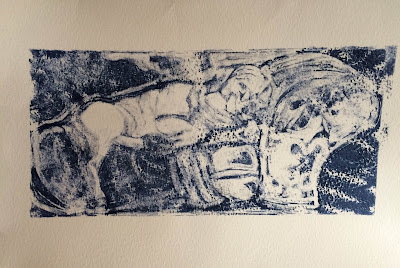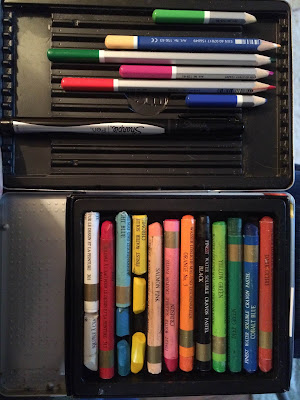 |
| "Lexie Love" Monotype with mixed media |
"Lexie Love" is my latest experiment with the dark field monotype and mixed media. Again, lots of mistakes happened (see below) but that's the fun part of learning a new art process.
 |
| Lexie, my yellow labrador retriever, is one of my favourite subjects. |
 |
| My taped off glass plate and black and white reference photo. |
I purchased some glass to use as my plate this time given my struggles using the "creative palette" and the acetate on my last two attempts. Glass is okay to use as a monotype plate if you are not using a press and hand printing.
I taped around the edges of the glass and then taped off a rectangle on the glass plate the size of my image using masking tape. This was really helpful when it came time to print!
I also purchased some non-slip material that Belinda Del Pesco recommends in her informative printmaking videos.
I printed my colour photograph in black and white to assist me in my inking.
INK: I used the AKUA Intaglio Payne's Gray again this time I rolled it on my inking plate and not directly onto the plate as I did on my first attempts.
PAPER: I planned to use some Canson watercolour paper that I had. I had bought it in large sheets and I reduced it to smaller pieces and I soaked it and I sprayed it again before hand printing.
 |
| The dark field monotype print. |
I was not entirely happy with this resulting print (above). The finer details on my inked plate were completely lost on the textured watercolour paper and my hand printing with the metal spoon resulted in some strange lines despite having moved the spoon very gently in small circles. I also noticed that the paper slipped somehow (see upper right hand corner.) resulting in a registration smudge.
I was hopeful that I could salvage the print with some mixed media work. The ink dries really fast and I used watercolour, gouache and pastel.
There were a couple of points where I wondered why wasn't I just painting on watercolour paper rather than printing and then painting? The answer, for me, is that there is something lovely about excavating the image from an ink-smeared sheet of glass and then the complete loss of control when you go to pull the print.
By adding mixed media to the monotype as your last step you get to play with your mistakes. I think that there are some interesting textures that emerge.
 |
| Interesting textures emerge |
I am really enjoying these experiments in printmaking. Stay tuned for the landscape, cityscape and architectural experiments next!












































